Headscarf
A headscarf, or head scarf, is a scarf covering most or all of the top of a person's, usually women's, hair and head, leaving the face uncovered. A headscarf is formed of a triangular cloth or a square cloth folded into a triangle, with which the head is covered.

Purposes
Headscarves may be worn for a variety of purposes, such as protection of the head or hair from rain, wind, dirt, cold, warmth, for sanitation, for fashion, recognition or social distinction; with religious significance, to hide baldness, out of modesty, or other forms of social convention.[1][2] Headscarves are now mainly worn for practical, cultural or religious reasons.
Until the latter 20th century, headscarves were commonly worn by women in many parts of the Southwestern Asia, Europe, North Africa, and the Americas, as well as some other parts of the world. In recent decades, headscarves, like hats, have fallen out of favor in Western culture. They are still, though, common in many rural areas of Eastern Europe as well as many areas of the Middle East.
A form of headscarf, known as the hijab, is commonly seen in Muslim countries and is born out of qur'anic tradition. It is worn primarily by Muslim women for fashion and religious purposes, and its style varies by culture.[3]
Religious use
Headscarves may specifically have a religious significance or function, or be expected as a matter of social custom, the two very often being confused.
Islam
Islam promotes modest dress among women. Many Muslim women wear a headscarf, often known as a hijab and in Quranic Arabic as the khimar. Many of these garments cover the hair, ears and throat, but do not cover the face. The Keffiyeh is commonly used by Muslim men, as for example Yasser Arafat who adopted a black and white fishnet-patterned keffiyeh as a hallmark.
Headscarves and veils are commonly used by observant Muslim women and girls, and required by law for women and girls in certain Muslim countries (Iran for example). The Muslim religious dress varies, and various cultures include burqa, chador, niqab, dupatta, or other types of hijab. The religion prescribes modest behaviour or dress in general, and in particular the headscarf worn by Muslim women and girls.[4]
Judaism
Religions such as Judaism under Halakhah (Jewish Law) promote modest dress among women and men. Many married Orthodox Jewish women wear a scarf (tichel, shmata ) to cover their hair. The Tallit is commonly worn by Jewish men especially for prayers, which they use to cover their head in order to recite the blessings, although not all men do this. It also may not apply to the entire prayer service, sometimes only specific sections such as the Amidah. The Kohanim (priests) also cover their heads and shoulders with the tallit during the priestly blessing so as to conform to Halakah which states that the hands of the priests should not be seen during this time as their mystical significance to the hand position.
Christianity

Until at least the 18th century, the wearing of a headcovering for the hair was regarded as customary for Christian women in Mediterranean, European, Middle Eastern, and African cultures, to agree with contemporary notions of modesty and as an indication of married status; the "matron's cap" is a general term for these.[5] This practice was derived from the Christian Bible, specifically, 1 Corinthians 11:4-13, which has traditionally been interpreted to mandate the wearing of a headcovering by Christian women.[5][6] To some extent, the covering of the head depended on where the woman was; indoors and at home it was less worn, but it was usual outside and on formal occasions, especially in church.[7] Women who did not wear headcoverings were interpreted to be "a prostitute or adulteress".[5][6] In Europe, law stipulated that married women who uncovered their head in public was evidence of her infidelity.[8] The Roman Catholic Church required all women to wear a Christian headcovering over their hair in church until the 1980s; in Spain, these take the form of the mantilla. Women meeting the Pope in formal audiences are still expected to wear them. Martin Luther, the German Reformer, as well as John Calvin, a major figure in the Reformed Churches, also expected women to cover their heads in church, as did John Wesley, the founder of the Methodist Churches.[9]
In many rural areas, women, especially widows, continue to observe the traditional Christian custom of headcovering, especially in the Mediterranean, as well as in eastern and southern Europe; in South Asia, it is common for Christian women to wear a headcovering called a dupatta.[10] At times the styles of covering using simple cloth became very elaborate, with complicated layers and folding, held in place with hair pins. Among the many terms for head-coverings made of flexible cloth are wimple, hennin, kerchief, gable hood, as well as light hats, mob caps and bonnets.
Many Anabaptist Christian women (Amish/Para-Amish, Brethren, Bruderhof, Hutterites and Mennonites) wear their headscarf at all times, except when sleeping.[11]
.jpeg)

In countries with large Eastern Orthodox Christianity population such as Romania [12] or Russia[13] headscarves and veils are used by Christian women in the Eastern Orthodox Church, Oriental Orthodox Church, Assyrian Church of the East, and Roman Catholic Church.[14][15][16] A few years back, all women in Russia who attended Divine Liturgy wore head-coverings. A woman having her head covered means that she honors the Lord. Head-coverings also symbolizes that a woman is married and that her husband is the head of the family. Little girls also have their heads covered when they go to Mass at church, not because they are married, but in order to honor the Lord. Today, young Russian Orthodox women and little girls still cover their heads when going to church, although it differs in style from those worn by women of older age (grandmothers).
Some English speakers use the word "babushka" (the word for 'grandma' in Russian: ![]()
Sikhism
Young Sikhs often wear a cloth wrapping to cover their hair, before moving on to the turban. Older Sikhs may wear them as an under-turban.
Use while working


_00399_April_1970_Airport_(rescan)_(37511910036).jpg)
Practical reasons for headscarf use at work include protection from bad weather and protection against industrial contamination, for example in dusty and oily environments. A headscarf can ensure that the hair does not interfere with the work and get caught-up in machinery since long hair can get into rotating parts of machines, so this is avoided either by means of a suitable head covering like a cap, hairnet or kerchief; cutting the hair short; or by putting on a headscarf. Hygiene also requires wearing a head cover at some workplaces, for example in kitchens and hospitals. Such usage has gone on since about 1900, when women's use of mob caps and Dutch bonnets declined.
Workers wore them at work to protect their hair from dirt. Farmers used them to see off the weather and dirt. Soviet labour units of the 1930s and 1940s wore them as part of their uniform (where uniforms were available). This habit was common until about the 1950s in the West for farmers and 1960s factory workers, and 1970s in the former USSR for farmers and factory workers.
In popular culture
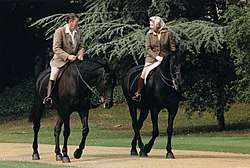
Hilda Ogden, popular character from the UK soap opera Coronation Street portrayed by Jean Alexander, became famous throughout the nation for combining a headscarf with hair curlers. So famous was she that, in 1982, she came fourth behind the Queen Mother, Queen Elizabeth II, and Diana, Princess of Wales in a poll of the most recognisable women in Britain.[17]
Image gallery
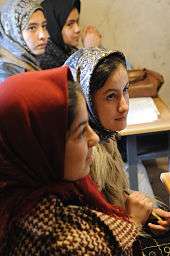 School girls in Herat, Afghanistan
School girls in Herat, Afghanistan Oil on canvas painting by Vittore Ghislandi, called Fra Galgario
Oil on canvas painting by Vittore Ghislandi, called Fra Galgario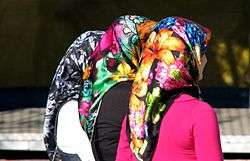
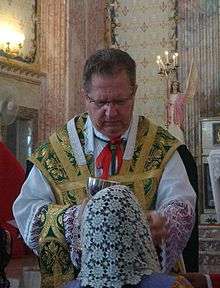 Distribution of Communion at a Tridentine Mass, women typically wear a headcovering.
Distribution of Communion at a Tridentine Mass, women typically wear a headcovering._-_TIMEA.jpg) A woman selling flowers. Egypt, 1906
A woman selling flowers. Egypt, 1906- Girls dressed up for a parade wear matching yellow headscarves. 2009, New Orleans, Louisiana.
 Woman with a headscarf in Gambia
Woman with a headscarf in Gambia Egypt, 1935
Egypt, 1935 A headscarf for chefs; Los Angeles, 2007
A headscarf for chefs; Los Angeles, 2007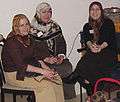 Three Turkish women wearing headscarves, 2003
Three Turkish women wearing headscarves, 2003 Laughing woman in Kuala Lumpur wearing a blue headscarf, 2008.
Laughing woman in Kuala Lumpur wearing a blue headscarf, 2008. A Malaysian girl wearing a headscarf, 2010.
A Malaysian girl wearing a headscarf, 2010. Women typical dress and headscarf; Nazaré, Portugal, 2006.
Women typical dress and headscarf; Nazaré, Portugal, 2006.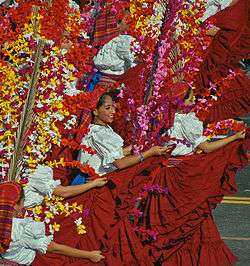 Salvadoran women wear distinctive regional veils for national celebrations.
Salvadoran women wear distinctive regional veils for national celebrations.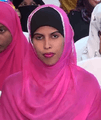 A young Somali woman in a traditional headscarf.
A young Somali woman in a traditional headscarf. A cancer victim in a head scarf after losing her hair due to Chemotherapy.
A cancer victim in a head scarf after losing her hair due to Chemotherapy. An Afghan girl wears an Islamic style scarf at the International Women's Day celebration in Pajshir in 2008.
An Afghan girl wears an Islamic style scarf at the International Women's Day celebration in Pajshir in 2008.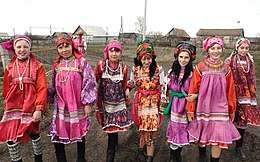 Scarved Moksha girls in traditional costumes.
Scarved Moksha girls in traditional costumes.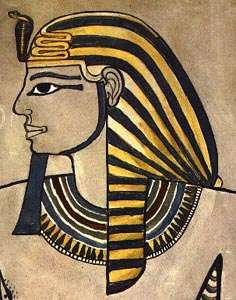 Amenhotep II in a Nemes headcloth.
Amenhotep II in a Nemes headcloth..jpg) The Molokans (Russian: Молока́не) are a religious sect, among Russian peasants (serfs), who broke away from the Russian Orthodox Church in the 1550s. Molokans denied the Czar's divine right to rule and rejected icons.
The Molokans (Russian: Молока́не) are a religious sect, among Russian peasants (serfs), who broke away from the Russian Orthodox Church in the 1550s. Molokans denied the Czar's divine right to rule and rejected icons. An early 19th-century Russian silk embroidered headscarf.[18]
An early 19th-century Russian silk embroidered headscarf.[18]
See also
| Wikimedia Commons has media related to Headscarves. |
References
- rosaliegilbert.com - Veils, Wimples and Gorgets
- christianity.stackexchange.com - What happened to the practice of women covering their heads?
- Sparrow, Mary (9 July 2018). "Understanding the Veil: A Primer in Muslim Women's Head Coverings [Photo Gallery]". International Mission Board. Archived from the original on 9 July 2018. Retrieved 27 November 2018.
- al-islam.org - Why Hijab?
- Hunt, Margaret (11 June 2014). Women in Eighteenth Century Europe. Taylor & Francis. p. 58. ISBN 9781317883876.
- Safran, Linda (21 March 2014). The Medieval Salento: Art and Identity in Southern Italy. University of Pennsylvania Press. p. 112. ISBN 9780812245547.
- Françoise Piponnier and Perrine Mane; Dress in the Middle Ages; pp. 40, 78-81, 95, 121, Yale UP, 1997; ISBN 0300069065
- Weitz, Rose (12 January 2005). Rapunzel's Daughters: What Women's Hair Tells Us About Women's Lives. Farrar, Straus and Giroux. p. 20. ISBN 9781429931137.
- Wesley, John. Wesley's Notes on the Bible. Christian Classics Ethereal Library. p. 570. ISBN 9781610252577.
- Boultwood, Anne; Hindle, Sian (8 February 2018). Culture, Costume and Dress. Gold Word Publishing. p. 80. ISBN 9781909379268.
- Almila, Anna-Mari; Inglis, David (6 July 2017). The Routledge International Handbook to Veils and Veiling. Taylor & Francis. p. 296. ISBN 9781317041146.
- "Women's Headcoverings". wordpress.com. 4 February 2014. Retrieved 14 April 2018.
- head covering history -
- orthodoxinfo.com - On Account of the Angels: Why I Cover My Head
- academia.edu - Head Covering Among Catholic Laity, a pdf-download page
- altcatholicah.com - Veiling in Church: Mantilla Manifesto
- Little, Daran (1995). The Coronation Street Story, p.188. London: Boxtree. ISBN 1-85283-464-1
- "Headscarf | Russian | The Met". The Metropolitan Museum of Art.
